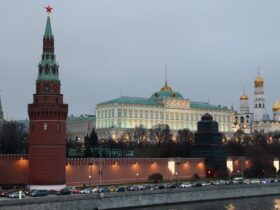Nuclear power produces no carbon emissions during operation, and has been introduced as a solution to meet the world’s rapidly growing energy needs.
But although it doesn’t pollute like fossil fuels, nuclear comes with its own set of environmental problems: among them, indirect emissions from uranium mines, contaminated water, radioactive waste and the risk of a Chernobyl-style disaster.
In recent months, tech giants Meta, Amazon, Microsoft and Google have announced plans to invest in nuclear power under the banner of carbon neutrality – despite pledges to rely entirely on renewable energy first. And as the deadline approaches to curb greenhouse gas emissions to keep global warming in check, some policymakers and financial supporters have also come out in favor of a renewed emphasis on nuclear energy.
Is nuclear power a realistic climate solution?
Nearly two years after Germany shut down its last nuclear reactors, the country’s conservative CDU/CSU opposition has called for more research into nuclear technology. The party also wants to investigate the possibility of bringing closed nuclear power plants back online.
With a view to the German federal election in February, the CDU/CSU election manifesto states that nuclear energy “has an important role to play, especially with regard to climate goals and security of supply.” The CDU’s candidate for chancellor, Friedrich Merz, has called Germany’s move away from nuclear power a “strategic mistake” but says it is unrealistic that the nation’s last reactors scheduled to be closed will be brought back online.
The far-right Alternative for Germany party is also pushing for a return to nuclear power as part of a “sustainable, serious energy mix”, with chancellor candidate Alice Weidel claiming in a recent interview with German broadcaster ZDF that this would include ” The CO2 footprint is “zero.”
Meanwhile, the ruling coalition of centre-left Social Democrats and Greens has ruled out a return to nuclear power, which is also linked to indirect emissions from the reactors’ lengthy and complex construction process.
Henry Preston, spokesperson for the World Nuclear Association (WNA), believes that policymakers have become more “pragmatic” in recent years, balancing energy security and the climate emergency, while also addressing increased costs and construction timelines. Are weighing in with the possibility of a “huge amount”. Of clean energy.
But environmental groups have consistently pointed out that expensive new nuclear projects, which typically take about a decade to build after all planning and permitting, will not come online fast enough to help meet climate goals.
Global climate campaigners Climate Action Network Europe said in an online fact check, “Rapid transitions require the use of existing technologies and solutions, which need the most, such as renewable energy, primarily solar and wind, energy efficiency and system resilience.” Can be implemented rapidly.”
“Renewables consistently outperform nuclear energy in terms of cost and speed of deployment and are therefore chosen over nuclear energy in most countries,” states the 2024 World Nuclear Industry Status Report (WNISR), which includes Plans have been outlined to boost nuclear capacity in the coming decades. Unreal.”
Are small modular reactors a safe option?
In the US, Amazon and Google plan to buy power from small modular reactors (SMRs), which are advanced nuclear plants with a capacity of less than 300 megawatts, about a third of a standard nuclear plant.
The tech giants have said nuclear power will help meet the huge energy needs of artificial intelligence and data centres, while also meeting their net-zero climate promises. Data centers and AI consume between 1% and 3% of the world’s energy supply today – a share that some analysts expect to double by 2030.
Joe Dominguez, CEO of Constellation Energy in the US, said data centers “need abundant energy every hour of every day that is carbon-free and reliable, and nuclear plants are the only energy source that can consistently deliver on that promise.” Can.” Announced a 20-year nuclear power supply agreement with Microsoft in September.
Proponents have said that SMRs would be safer, cheaper and faster to bring online than conventional reactors, and could be built on the sites of former fossil fuel plants. The US partnership with Amazon and Google is estimated to be operational by the early 2030s.
But the Climate Action Network has argued against the “empty promises” of SMR, stating that “the technology has not yet been tested on a commercial scale.” Globally, only two SMR projects have been built so far, each with reactors of different Russian and Chinese designs. They were connected to the grid in 2019 and 2021 respectively.
wnisr reportPartly funded by Germany’s Ministry of the Environment, both projects reported significant construction delays, with construction taking two or three times longer than initially planned. They also went over budget and have underperformed so far in terms of power generation.
However, the nuclear industry has said the delay is not a surprise as Russia and China were the first SMR pilot projects built. WNA’s Preston, speaking to DW from London, said future projects now in the planning stages “could potentially come online faster.”
But Michael Schneider, an independent nuclear policy analyst and publisher of the WNISR report, said in an email that this would only be possible with “reproduction of identical or nearly identical units,” rather than SMRs of different designs as Russia and China have. with. ,
Schneider said the rapidly increasing production of solar panels, grid-connected batteries and wind turbines, thousands of units of which are built each year, represents “truly modular manufacturing” that is allowing those industries to innovate and rapidly reduce costs. Allows to reduce.
“The nuclear industry has learned from SMR pilots in China and Russia that no one wants to reproduce them, and there has been no effort to license them in any Western country,” Schneider said.
Do we need nuclear power to meet climate goals?
At the 2023 climate summit in Dubai, nuclear energy was listed for the first time among the low-emission technologies needed to achieve “deep, rapid and sustained reductions in greenhouse gas emissions”.
The UN Intergovernmental Panel on Climate Change 2022 report also mentions nuclear power, saying that “it is unlikely that all low-carbon energy systems around the world will rely entirely on renewable energy sources.”
Considering that wind and solar energy are expected to play a major role in the effort to replace fossil fuels, energy analysts have often spoken of the unreliability of renewable energy, which depends on the availability of sun and wind.
Since the Dubai climate conference, 31 countries – including major nuclear players such as France, the United Kingdom, the United States and Japan – have pledged to triple capacity by 2050. Non-nuclear countries such as El Salvador, Jamaica, Moldova and Mongolia have done likewise – although China and Russia are the only two countries that have not started nuclear reactor construction in the past five years.
However, the 2024 WNISR report casts doubt on that pledge. Listing a number of potential obstacles – high costs, construction time, lack of industrial capacity – the report notes that tripling the current installed capacity would require more than 1,000 new reactors.
Even with SMRs contributing significant amounts of energy, “hundreds or even thousands of things would need to be built to get even close to that objective,” Schneider said in an interview in December 2023. . Bulletin of Nuclear Scientists,
Edited by: Stuart Braun






Leave a Reply